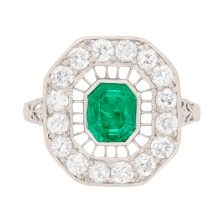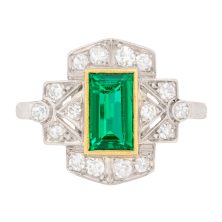The Mesmerising Emeralds of May: All you need to know about Emeralds
The birthstone of May is the majestic Emerald, a common gemstone, known for it’s beautiful and varying green colour. It is one of the most sought-after gemstones in the market, being considered one of the top four alongside sapphires, rubies and of course, diamonds. The quality of an Emerald is all in the colour. Whereas a peridot or tourmaline may have strong blue/green hues, an emerald sparkles green as the predominant colour.

Emeralds are the given gift on a 55th wedding anniversary, which highlights their exclusivity and high market value. Although they are made from beryl, which is the same mineral as an aquamarine stone, the composition allows the gemstone to be slightly harder and of higher value. However, emeralds are by no means the hardest gemstones. They are commonly used within dress rings to allow the emeralds to be quite big. The larger the stone, the easier it is to cut and set within jewellery. Emeralds are the softest of the top four gemstones and can be more susceptible to chipping and cracking.
The rich green colour, which makes emeralds infamous, comes from different elements within the stone’s composition. The two key elements are Vanadium and Chromium. They also have a much lower density than say diamonds, which can make them appear to be larger in weight. Most of the highly sort-after emeralds are Colombian. Colombia yields one of the highest amounts of emeralds across the globe, however they are becoming more common with places such as Zambia and Brazil. Colombian emeralds are higher in price.
Emeralds have an interesting history, with the first recorded mines being in Egypt. This was dated around 1500 BC and history has recorded the great Cleopatra adored emerald stones. She had quite an extensive collection! Moving forward to the 16th century and the Spanish were trading emeralds across Europe, Asia and South America. A lot of the emerald stock was coming from South America at this time, as it is now.
The majority of emeralds on the market are natural and will have received some level of treatment, however, in 1935 synthetic

emeralds were created. This was almost 30 years after synthetic sapphires and rubies were created.
All-natural emeralds will include inclusions and imperfection. Oiling treatment can be used to enhance the colour and cover these inclusions as well; however, it does have a significant effect on the price. In terms of valuing an emerald, the key factors are the colour, the carat weight and the origin. We recommend asking for certificates on all large emerald stones, as the price can change largely if not considered.
Emeralds have long sat within the folklore of history as well. It is believed that if an emerald is placed under the tongue, it can allow the person to see into the future. It was also largely used to help with periods of concentration and can relive eye strain.
We have a large selection of emerald goods and our top tip is to be very careful when cleaning your emerald jewellery. Use warm water and a soft toothbrush rather than ultrasonic cleaners to avoid any internal damage.





